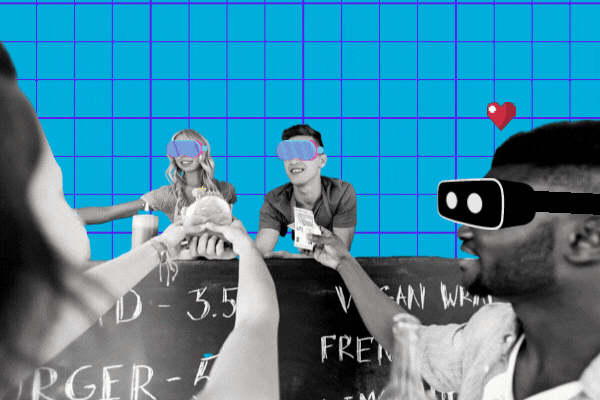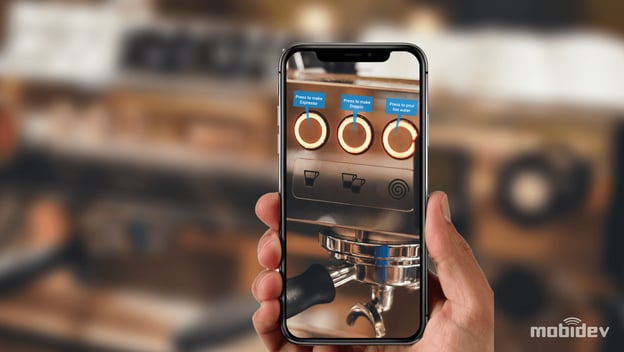There are predictions that Metaverse could reach the $800B mark by 2024, as it is already sitting at around $47B thanks to a surge of interest in 2020 when the pandemic peaked.
So, as people spend more time in the metaverse, brands have to meet them there. With a Gartner study predicting that 25% of people will spend at least an hour a day in the ‘verse by 2026, the brands which consider what their customer experiences will look like now have the opportunity to pull ahead.

Going into a shop isn’t enough for customers anymore. They need to be introduced to a new brand of lipstick by a giant octopus man aboard the starship enterprise. Okay, maybe I’m exaggerating. The numbers don’t lie, however; 71% of customers say they would shop more often if they could use AR.
But the metaverse offers customers the most immersive, exciting experience out there, complete with gamification, personalisation, and instant problem-solving. All with the added bonus of maybe getting to fight an alien with a laser sword.
The emergence of the ‘verse means companies have the opportunity to create meaningful, personalised customer experiences, but this requires them to be virtually active. This can be achieved through understanding the space, or even through hiring metaverse-specific team members who can understand the space for you. But baby steps first.
A report by TechRepublic has recently found that 91% of enterprise companies are already using, or are planning to adopt, metaverse-related technology in the coming years. And what are they using it for, you may ask? Well:
- 60% are using VR/AR to supplement production and labour
- 53% use it for customer care
- 53% for design and product engineering
- 26% for corporate training
But for anyone who is still getting their heads around the concept, let’s ask:
What is the metaverse?
Basically, the idea behind the metaverse is to create a space similar to the internet, but more tangible, so that users can interact with the world via digital avatars. Plus, unlike the modern internet, metaverse users experience environmental changes in real-time. If a user makes a change to the metaverse, this shift is visible to everyone.
In theory, you could sit around a virtual meeting table with colleagues from around the world, then break for lunch and head to a virtual art expedition, and then meet up for dinner with your friends when work ends.
We will see a shift in the way people play, work, learn or simply hang out in 2021," says David Bazucki, CEO and Founder of Roblox.
"Some of this connection will move into the Metaverse, a digital place where people seamlessly get together and interact in millions of 3D virtual experiences. Early iterations of the Metaverse emerged in the 1980s with VPL Research’s DataSuit and Linden Lab’s Second Life in 2003.
However, it started to feel very real in 2020 as several platforms have been envisioning – and building – their own versions of the Metaverse.”
So, what makes it different to the internet? Well, current online platforms allow users to move about within the confines of the service, but limit interoperability between platforms. I mean, Twitter's aim is to get you to stay on Twitter, no matter what.
"You can build anything in “Minecraft,” but you can’t transfer your creations into a “Fortnite” map. The Metaverse will allow users to generate their own content and distribute it freely throughout a widely accessible digital world," reports Digiday's Alexander Lee.
So, how will this space innovate customer experience? How will it create a space so immersive, your potential clients will never want to leave? Well, it all starts with:
Creating Deeper Levels of Personalisation
The metaverse has shown itself to be a space where experiences can be personalised to the highest degree, be it the gaming experience, the user experience, or the customer experience. This is because the metaverse allows for a great deal of personal customisation, with each consumer having access to an experience unique to them.
From choosing their avatars based on gender, age, social networks, and personal interests, to specific preferences such as colour or themes, customers can experience the metaverse in whichever way they choose.
And the customisation isn’t just a one-way street. Companies can also customise ads, and make it incredibly easy for customers to choose from a variety of options. This ultra personalisation contributes to the formation of a super memorable experience and strengthens customer loyalty.
But what facilitates all this personalisation? Luckily for marketers, the metaverse is a zero-party data factory. This easily collected information can then be utilised in an above-board way to create these hyper-personalised experiences your digital customers will have grown to expect.
But where does all this data come from? Well, in April 2021 alone, Fortnite players spent over 3.2B hours in-game. That’s a billion with a b. In the first quarter of 2021, people spent nearly 10 billion hours playing Roblox, according to the company’s earnings report, and more than 42 million users log in each day. This is only expected to increase, as more users are beginning to spend a significant amount of time-consuming digital media. In fact, on average, people will spend 16:06 hours a day with digital media, according to the Washington Post.
This significant time spent online gives companies the opportunity to collect and analyse huge swaths of information, and will ensure businesses and platforms become more engaging and relevant.
Gamifying the Customer Experience
The younger generations are not only open to the idea of life online, they’re anticipating it. In fact, 48% of Millennials and 38% of Gen Z believe that the metaverse will be part of their daily lives in the next ten years.
This also means these generations are preparing themselves financially for the space, with 51% of millennials and 37% of Gen Z stating that owning unique assets in the metaverse is a justified expense.
So, these generations are prepared to experience a chunk of their lives online. This includes eCommerce. The metaverse offers the opportunity to transform this space, at a time when IRL brick-and-mortar shops are declining. With avatars as shoppers, universes inspired by videogames, and easily customisable products, gamification takes the next step in the evolution of the customer journey.
This gamification of the customer journey means you can reward your clients for making their way through the ‘levels’. But this means you need to design a metaverse customer journey. Ask yourself: “What will your customers do in the ‘verse? What places do you think will interest them? Will the storefront keep them invested? How are you planning to enter the market? Can you offer real-time feedback? Will they be provided with self-help resources? Can you accelerate the immersive journey?” It’s all about trying to match the unique aspects of the metaverse, with more traditional customer journey touchpoints.
Developing Brand Specific Content
The ‘verse gives brands the opportunity to go a bit buck-wild, a develop immersive experiences for their customers beyond anything they’ve seen before.
Companies can create entire ecosystems with their own rules, spaces, and physics, allowing for endless possibilities with gameplay and storytelling.
For example, in 2021 Hyundai announced their own metaverse space on Roblox, in which users can engage with the company’s products. Then, in 2022, they presented their “metamobility” concept, which merged the use of vehicles and robots, to connect the virtual and real world.
This is not the first brand to provide a unique experience within Roblox. Roblox and Gucci teamed up last year to develop an innovative user experience. The brands hosted the 'Gucci Garden' on the Roblox platform, a two-week art installation aimed at building brand awareness among younger users.

Ahead of its centenary, Gucci developed the event to be a virtual recreation of a real-world installation in Florence. The Garden offered various themed rooms paying homage to the brand's campaigns, with metaverse benefits including the ability to transcend the laws of physics.
When visiting the area, visitors could try on and purchase digital Gucci products, and then go on to explore the themed rooms. As they explored the virtual world, the avatars absorb elements of each area.
To ensure the partnership was fair and collaborative, both the platform and the brand received value from any sale of the virtual clothing, with the items being sold via a revenue share model.
Giving Customers a ‘Try Before You Buy” Experience
An immersive, interactive, and realistic experience gives your customers the chance to try your product before they commit to it, avoiding costly returns and customer service hotlines.
Already, retail brands such as cosmetics and vehicle industries are using these immersive technologies to allow customers the chance to gain an accurate visual perspective and make informed purchases.
This can also be useful for furniture brands, such as with Ikea’s place AR app, which gives customers the chance to place digital copies of furniture in their home, to check the size and colour works for them.
Ikea's AR Christmas calendar is also pretty popular every year, allowing users to see what size and style of Christmas tree will fit their homes.
This is a natural, and festive, extension of their Ikea 'Place' app which gave customers a view into what certain furniture would look like in their room, before making a purchase.

Providing Post-Purchase Customer Service and Support
So, the metaverse doesn’t just look after your customers' pre-purchase and during the purchase, but it’s all about the post-purchase too.
The metaverse doesn’t have to be all about creating the maddest, most eye-catching marketing gimmicks. It can also provide more practical and vital support needed throughout the customer journey.
For example, let’s take a look at Nespresso’s AR descaling instructions. Customers can unlock a step-by-step guide by scanning the packaging with their phone, which can help them through the process in real time.

Although this isn’t the flashiest, most high-tech example of the metaverse or AR, it has identified and addressed an issue that customers had been experiencing, and which had probably blocked up customer service phone lines. This makes the AR tech a practical tool to improve the customer experience, instantly and smoothly.
Improving Public Relations
By using the metaverse to activate PR programmes, companies and brands can extend their reach to a global audience, and ensure their relationship with customers is fun and interactive.
Plus, the metaverse provides an opportunity for brands to create an experience which builds brand awareness, and as a result customer loyalty, thanks to this improved relationship.
So, a company could create a virtual reality tour of their building, shop, or facility, or even host a virtual event that allows users to learn about the company, and interact with their products and services. They could even host a virtual press conference or satellite media tour in the ‘verse.
Training Employees and Developing Learning
When your employees are trained to their highest capacity, then they’ll be able to utilise their skills to provide your customers with the best customer experience.
One of the best examples of the corporate metaverse space at the moment is Microsoft.
Microsoft is on its way to creating the 'enterprise metaverse', which some companies are using to speed up production, both in terms of products and staff. Teams have been connecting employees across the globe, and introduced real-time avatars recently, showing the capability for Metaverse elements to be normalised in an office setting.
Anheuser-Busch InBev is using Microsoft's enterprise metaverse to track every bottle through the manufacturing and distribution process. This map of production is overlaid across their physical brewery and understands the relationship between equipment and natural ingredients. This enables the brewers to make adjustments and monitor their supply chain to run as efficiently as possible.
The metaverse can also a great tool for corporate training and development. It can give employees a realistic and interactive environment to learn new skills, and gain knowledge.
So, the metaverse can be used to simulate real-world scenarios, allowing employees to test their skills in a safe and controlled setting. And it works. In fact, one study from PwC found that employees:
- Can be trained up to 4X faster in a virtual reality space
- Are more confident applying what they learned after training in the metaverse
- Could be 4x more focused during training when using the metaverse
- 3.75x more emotionally connected to educational content learned in VR
The metaverse’s customisation and penchant for unique experiences don’t just extend to your customers. In fact, it can be used to create custom training programmes specifically tailored to your employee’s and company’s needs. For example, if your company is launching a new product, you can create a VR simulation which allows employees to experience the product pre-launch. Then, they can learn all about its features and benefits, and become a well-informed advocate for the product.
How will the Metaverse Change Customer Behaviour?
Now, this is the big question. Not only will the metaverse impact the way brands operate and interact, but it’ll change the way consumers behave and how they consume content. In the same way the internet has shifted customers away from purely going into a store and making a purchase, the metaverse will shake up the commerce space.
In the metaverse, buying products will be even more accessible and convenient. As we’ve mentioned consumers can test-drive products, try on makeup and clothes, and even walk through an open house before they make a decision on a property, or purchase a piece of furniture, without leaving their living rooms.
The metaverse is likely to change company strategy in its ability to create new opportunities for marketing and advertising. At the moment, companies might be reliant on billboards, TV adverts, and on-site ads to reach potential customers. But in the metaverse, companies can create virtual storefronts which people can visit regardless of where they are in the world. This can allow brands to target a much larger audience than before.
What are the Challenges with the Metaverse?
Before jumping into the fray, brands have several key points and issues to consider. These can include their target audience, the technology needed for them to operate optimally in the metaverse, being able to create virtual-first experiences that can deliver a truly virtual experience, and conducting studies and tests to learn more about the buyer’s journey and customer experiences within the context of the metaverse.
When it comes to challenges that might come up with the adoption of virtual CX, companies should look to the current state of chatbots. “Many brands think that chatbots alone can solve every customer interaction—but current technology can’t meet customers’ complicated needs alone,” said Rodriguez.
He adds that brands shouldn’t adopt virtual CX and force it to become something that it’s not. They should instead focus on building a metaverse channel and how it could be used to meet individual customer needs efficiently and “with empathy in a whole new space.”
What about poor user experience in the metaverse? “Poor customer experiences will reverberate more loudly in unified metaverse communities,” Rodriguez commented on the implications of poor CX in the virtual world. “As the metaverse becomes adopted by more people, brands that fail to cultivate loyalty through their CX will instead see larger customer migrations to their competitors.”
But there’s also the first few hiccups that need to be figured out before companies are ready to move into the space. The first to consider is that sharing the metaverse space between competing companies may cause some issues. Companies owning metaverse space would need to be open to interconnecting their worlds, so people can roam freely between them. This is the entire point of the metaverse - it needs to be interconnected.
The onboarding process might also cause issues. Retailers may not be keen to invest in a model that is not tested or the potential is unknown.
The costs of setting up metaverse retail estate could also be high compared to traditional e-commerce spaces, or even brick and mortar shops. For example, brands would need to consider a bunch of expenses, such as tech, human resources, use of AI, blockchain, AR/VR, research and development, and creating and managing digital identities which need to be verified and authenticated.
On top of all this, the content needs to be free-flowing and constant. Not a small ask. To fuel constant customer engagement, brands will need to invest their time and budget in being able to produce an endless amount of content tailored to customer tastes and behaviour patterns.
So, the metaverse has the opportunity for brands to provide customers with engaging and innovative customer experiences. Right now, even though the metaverse is in its fledgling stages, the novelty and intrigue of the space are enough to draw customers in. By capitalising on this, brands will develop stronger relationships and brand awareness, whilst preparing for the metaverse-heavy customer experiences of the future. Though the space has its challenges, by being aware of the issues, companies can profit from an interesting and innovative space.
